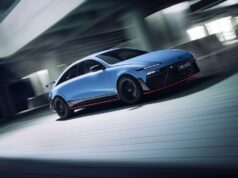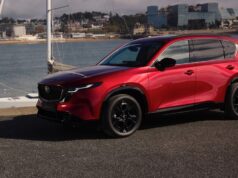
Ford is going to unveil its newest engine technology at the Detroit Auto Show this month.
The new engine technology label EcoBoost delivers up to 20 percent better fuel economy than Ford’s current engines. The new 4-cylinder and 6-cylinder engines feature turbocharging and direct injection technology. Ford sees this new engine technology as a cheaper alternative to hybrids and diesel engines, which provides improved fuel economy with any compromises in driving performance.
The first vehicles to receive this new technology will be the 2009 Lincoln MKS and the upcoming Ford Flex. The Lincoln MKS will feature a 3.5L twin-turbocharged V6 that puts out 340 horsepower and more than 340 lb-ft. of torque. This engine will take the place of a normal V8 in the MKS lineup. Compared to a normal V8 the EcoBoost 3.5L V6 has V8-like performance but is lighter and achieves better fuel economy.
Ford expects to power half a million vehicles with this engine technology within the next five years.
Related Stories:
2009 Lincoln MKS Officially Unveiled…Will Lincoln’s New Design DNA Work?
Ford Has Announced Plans to Add Turbos to Its Engines to Increase Fuel Economy…Will it Work?
PRESS RELEASE:
FORD TO EQUIP HALF A MILLION VEHICLES WITH ECOBOOST ENGINE TECHNOLOGY FOR UP TO 20% BETTER FUEL ECONOMY
DETROIT, Jan. 6, 2008 – Ford Motor Company is introducing a new engine technology called EcoBoost that will deliver up to 20 percent better fuel economy on half a million Ford, Lincoln and Mercury vehicles annually in North America during the next five years.
The EcoBoost family of 4-cylinder and 6-cylinder engines features turbocharging and direct injection technology. Compared with more expensive hybrids and diesel engines, EcoBoost builds upon today’s affordable gasoline engine and improves it, providing more customers with a way to improve fuel economy and emissions without compromising driving performance.
“EcoBoost is meaningful because it can be applied across a wide variety of engine types in a range of vehicles, from small cars to large trucks – and it’s affordable,” said Derrick Kuzak, Ford’s group vice president of Global Product Development.
“Compared with the current cost of diesel and hybrid technologies, customers can expect to recoup their initial investment in a 4-cylinder EcoBoost engine through fuel savings in approximately 30 months. A diesel will take an average of seven and one-half years, while the cost of a hybrid will take nearly 12 years to recoup – given equivalent miles driven per year and fuel costs,” he said.
Ford will introduce EcoBoost on the new Lincoln MKS flagship in 2009, followed by the Ford Flex and other vehicles. By 2013, Ford will have more than half a million EcoBoost-powered vehicles on the road annually in North America.
In 2009, Ford first will introduce EcoBoost on the Lincoln MKS featuring a 3.5-liter twin-turbocharged V-6. It will produce the power and torque of a V-8 engine with the fuel efficiency of a V-6. In fact, with an estimated 340-horsepower and more than 340 lb.-ft. of torque, the Lincoln MKS will be the most powerful and fuel-efficient all-wheel-drive luxury sedan in the market.
More With Less
EcoBoost’s combination of direct injection and turbocharging mitigates the traditional disadvantages of downsizing and boosting 4- and 6-cylinder engines, giving customers both superior performance as well as fuel economy.
With direct injection, fuel is injected into each cylinder of an engine in small, precise amounts. Compared to conventional port injection, direct injection produces a cooler, denser charge, delivering higher fuel economy and performance.
When combined with modern-day turbocharging – which uses waste energy from the exhaust gas to drive the turbine – direct injection provides the best of both worlds: the responsiveness of a larger-displacement engine with fewer trips to the gas pump.
Ford’s 3.5-liter EcoBoost V-6, for example, can deliver upwards of 340-plus lb.-ft. of torque across a wide engine range – 2,000 to 5,000 rpm versus 270 to 310 lb.-ft of torque for a conventional naturally aspirated 4.6-liter V-8 over the same speed range. At the same time, this V-6 gives customers an approximate 2 mpg improvement and emits up to 15 percent fewer CO2 emissions to the environment.
Direct injection coupled with turbocharging allows for the downsizing of engines that deliver improved torque and performance. A small 4-cylinder EcoBoost engine has the capability of producing more torque than a larger 4-cylinder engine – nearly an entire liter larger in displacement – with better fuel efficiency.
The real-world fuel economy benefit is consistent no matter the drive cycle, meaning the engine is efficient in the city as well as on the highway – unlike hybrids, which are most efficient in stop-and-go traffic. In addition, customers who tow and haul – and have long turned to more expensive diesel powertrains for their superior towing capabilities – can find the engine performance they need from an EcoBoost powertrain.
EcoBoost – combined with multi-speed transmissions, advanced electric power steering, weight reductions and aerodynamic improvements – is part of Ford Motor Company’s strategy to deliver sustainable, quality vehicles that customers want and value. Additional hybrid offerings and diesel engines are planned for light-duty vehicles.
Longer term, Ford plans to remain aggressive in the development of plug-in hybrids and hydrogen fuel cell-powered vehicles.
“We know that what will make the biggest difference is applying the right technology on volume vehicles that customers really want and value and can afford,” said Kuzak. “EcoBoost puts an affordable technology within reach for millions of customers, and Ford’s systems approach adds up to a big idea that differentiates Ford’s sustainability strategy in the market.”












